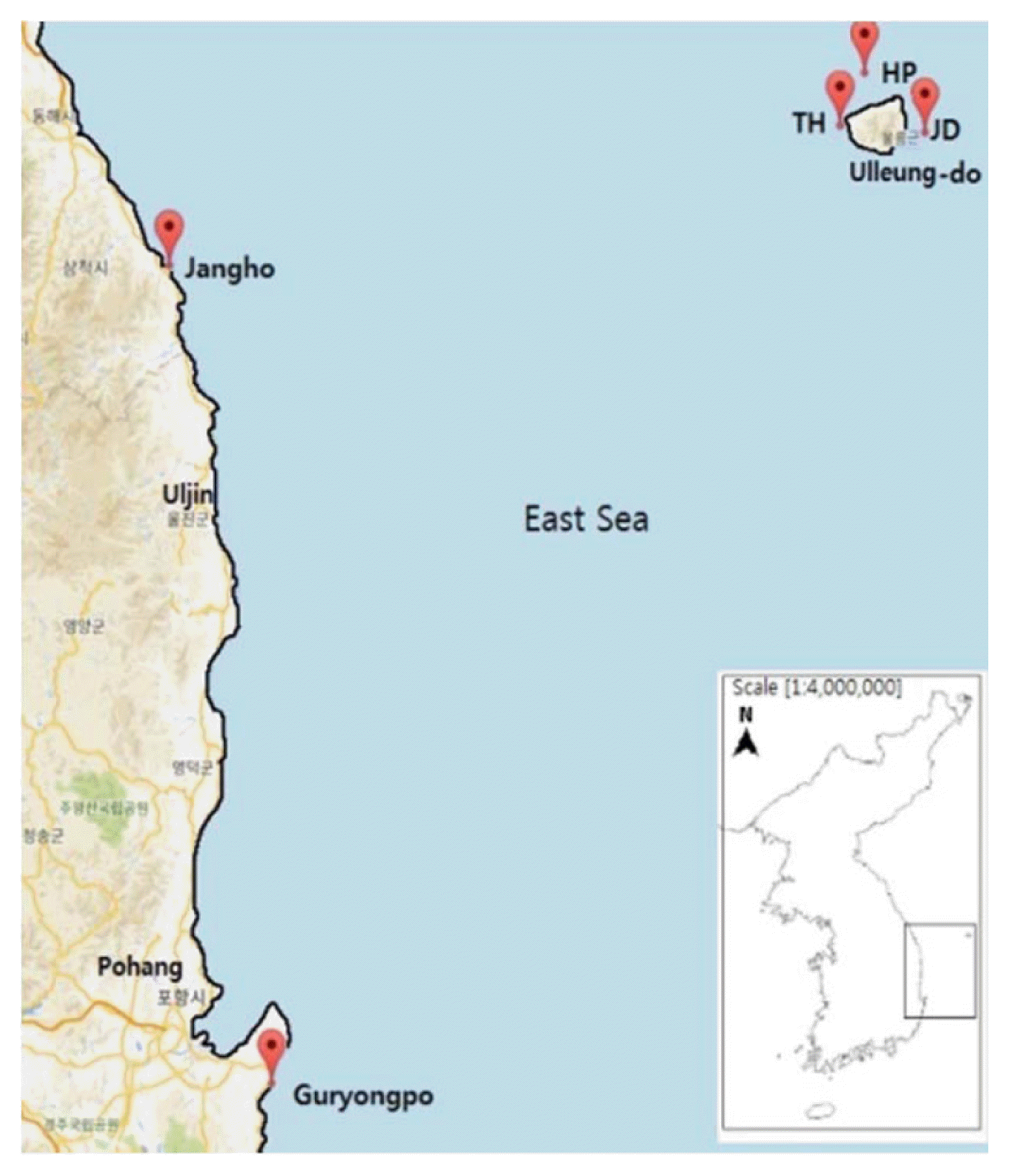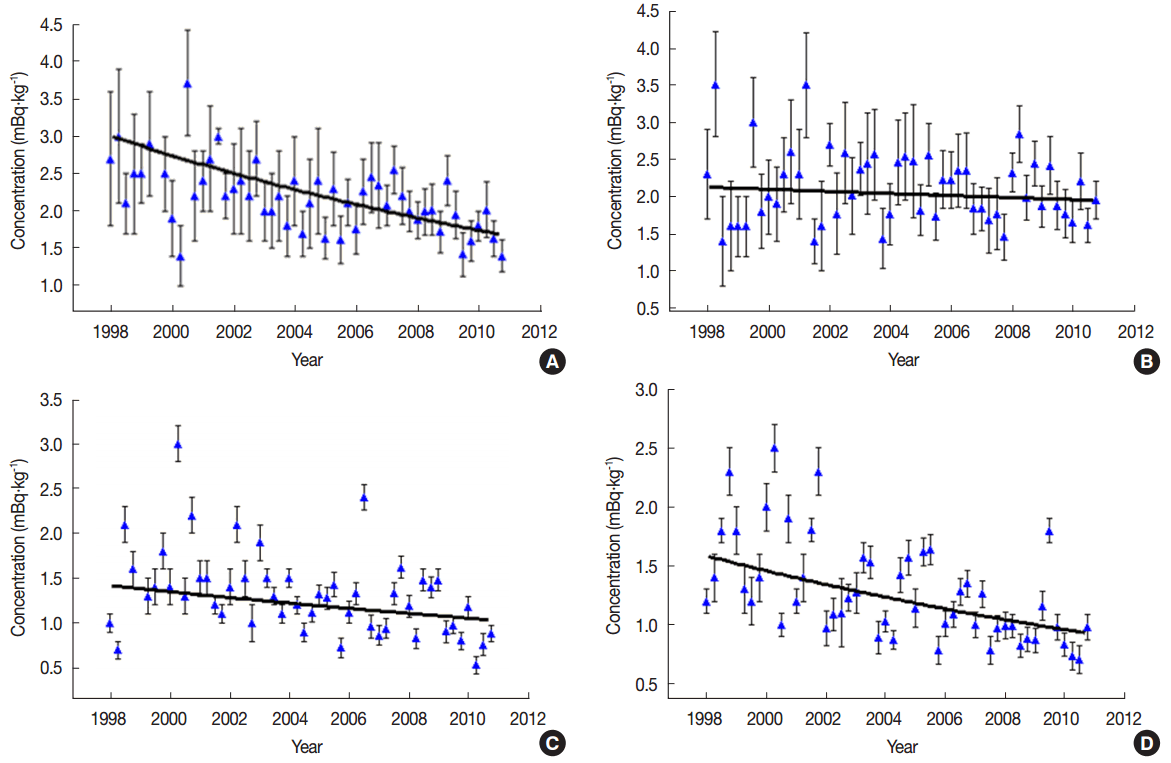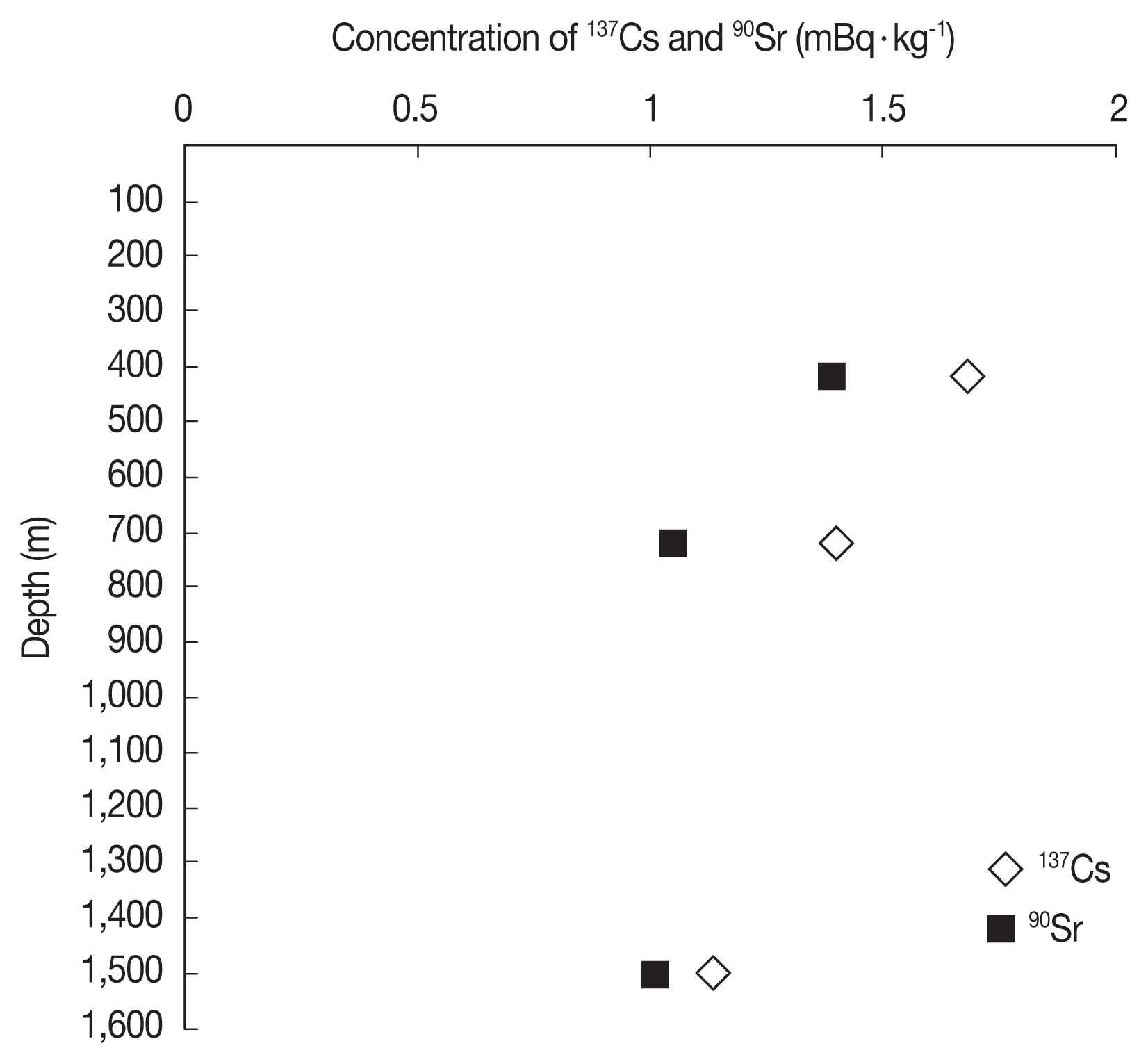Introduction
Detectable artificial radionuclides in marine environments entered the system as radioactive fallout from atmospheric nuclear tests conducted in the late 1950s and early 1960s, the Chernobyl disaster, outflow of radioactive materials from the operation of nuclear power plants, and dumping of nuclear waste. The most common cause is radioactive fallout from atmospheric nuclear tests [1]. The concentrations of 137Cs and 90Sr that have entered the ocean from radioactive fallout from atmospheric nuclear experiments is reported to be 603 PBq and 377 PBq, respectively [2].
Research regarding current radionuclide concentrations and prediction of future concentrations is of utmost importance, because oceans cover more than 70% of the Earth’s surface and the influence from radionuclides still continues today. The radionuclides 137Cs and 90Sr are found in abundance in the ocean and have relatively long half-lives (30.2 y and 28.8 y, respectively); these radionuclides are also important in measuring radiation dose in humans and marine life. 137Cs is a Group 1 element that exists in the form of an alkali metal ion. 90Sr is a Group 2 element that exists in the form of an alkaline earth metal. Both are water solubility nuclides, known to be capable of physical behaviors such as diffusion and dilution [3].
The Radiation Science Research Institute at Kyungpook National University analyzed the activity concentration levels of 137Cs and 90Sr in the surface water of the East Sea from 1998 to 2010 as part of an environmental radioactivity surveillance investigation. The results of that investigation were used to evaluate changes in the activity concentration levels and effective half-lives of 137Cs and 90Sr. This paper also includes the activity concentration of 137Cs and 90Sr in the deep seawater of the East Sea measured by the Kyungpook National University Radiation Science Research Institute from 2012 to 2015 due to a request from the Gyeongbuk Institute for Marine Bio-Industry for deep seawater development.
Materials and Methods
Surface seawater samples were collected from Guryongpo and Jangho in the East Sea, while the deep seawater samples were taken from three sample areas (TH, JD, and HP) adjacent to Ulleung-do (locations shown in Figure 1). Samples were collected quarterly. Table 1 shows the location of sampling, the sampling period, and the sampling depth.
The pretreated seawater infiltrant ammonium molybdo phosphate (AMP) was used to analyze cesium radionuclides in seawater samples. AMP has been widely used for 137Cs analysis in ocean water due to its high absorption rate of cesium [4]. For every kilogram of acid-treated seawater (a total of 60 kg), 0.5 g of AMP was added, followed by an hour of thorough mixing using an agitator and 48 hours of settling for the solution to precipitate. The precipitate was passed through filtration paper (0.45 μm pore size), then collected in a cylindrical beaker (80 mL) [5]. Recovery ratio of the added AMP was maintained above 70%. Measurements were conducted with a high purity germanium gamma spectroscopy system (GC-3019-7500SL, Canberra Inc., Meriden, CT/GEM-25185-P, Ortec, Oak Ridge, TN). The software program APTEC (Canberra Inc., Meriden, CT) was used to analyze the activity concentration of 137Cs. For analysis the energy tolerance was set at 0.75 keV, with an abundance limit of 40%, and a confidence level of 1σ.
90Sr was chemically pretreated for analysis using Willard and Goodspeed’s fuming nitric acid method [6]. Although there are other methods other than nitric acid fuming such as ion exchange [7] and Sr-resin [8], such methods require a large quantity of reagents and can lower the recovery ratio for seawater samples that have a high calcium content. Fuming nitric acid method can be applied to all environmental samples including seawater, and is the most commonly used method of pretreating samples for 90Sr analysis despite producing nitric acid fumes in the process.
Seawater sample was taken through the carbonate precipitation process, followed by an oxalate precipitation process, then finally by the fuming nitric acid process. The sample then underwent the scavenging process, which removes lanthanide (such as 140La formed by the breakdown of 140Ba) and yttrium (90Y formed from the breakdown of 90Sr) radioactive nuclides. The solution was settled for 14 days so that the 90Y and 90Sr reached radioactive equilibrium. An yttrium carrier solution was added to form yttrium hydroxide precipitate. The precipitate was dissolved using hydrochloric acid, followed by oxalic acid to produce an yttrium oxalate precipitate of 1.2–1.5 pH. The precipitate was then attached to a planchet and measured using a low-level alpha/beta proportional counter (Model S5E, Canberra Inc., Meriden, CT). The recovery ratio was calculated by comparing the mass of the strontium carbonate precipitate (formed when ammonium carbonate was added immediately after the scavenging process) with the mass of strontium in the seawater (calculated by measuring the stable strontium). A recovery ratio of at least 60% was maintained.
The minimum detectable activity (MDA) required by regulation [9] is 3 mBq·kg−1 (137Cs) and 1 mBq·kg−1 (90Sr ) in seawater for the analysis of radioactive concentration (Nuclear Safety and Security Commission Notice 2014-12. Regulations on environment radiation survey and environmental radiation impact assessment around nuclear facilities).
Results and Discussion
1. The Distribution of Activity Concentration of 137Cs and 90Sr of Surface Seawater
Surface seawater in each location was collected quarterly (4 times a year) and the activity concentration of 137Cs and 90Sr was measured for each sample. The activity concentrations were used to calculate a weighted average using an uncertainty of measurement (an uncertainty of 1σ using a Poisson distribution) reflecting the annual average activity concentration. The results are shown in Table 2. In the East Sea, for the last 13 years (1998–2010), the range of 137Cs activity concentration was 1.40–3.70 mBq·kg−1 at Guryongpo and 1.40–3.50 mBq·kg−1 at Jangho. The range of the annual average activity concentration was 1.66–2.89 and 1.68–2.43 mBq·kg−1 for Guryongpo and Jangho respectively, indicating that the difference in concentration based on location was very small.
The range of activity concentration of 90Sr in the same locations were 0.53–3.00 mBq·kg−1 for Guryongpo and 0.70–2.5 mBq·kg−1 for Jangho. The range of the annual average activity concentration was 0.83–1.98 mBq·kg−1 in Guryongpo and 0.82–1.57 mBq·kg−1 in Jangho.
According to analyses conducted by Hirose et al. [9] on samples taken in 1994, the activity concentrations of 137Cs and 90Sr in the surface seawater near the border of Korea, Japan, and Russia was 2.8–3.6 mBq·kg−1 and 1.6–2.0 mBq·kg−1. Analyses conducted by Povinec et al. [10] in the late 1990s reported 137Cs activity concentration of 1.5–3.6 mBq·kg−1 and 90Sr activity concentration of 1.49–2.20 mBq·kg−1. According to an investigation conducted from 2005 to 2014 by the Korea Institute of Nuclear Safety [5,11], the range of the annual average activity concentration of 137Cs in the East Sea was 1.13–4.50 mBq·kg−1, while the annual average activity concentration of 90Sr ranged from <0.241–1.64 mBq·kg−1, which are similar to the values reported in this paper. The summary of comparison of the previously reported activity levels is shown in Table 3.
The ratio of the average activity concentration between 137Cs and 90Sr was 1.01–2.37 (average, 1.72) in Guryongpo and 1.14–2.57 (average, 1.72) in Jangho, as shown in Table 2. These values were similar to the global radioactive fallout ratio (1.6 [12] and 1.8 [13]).
In order to evaluate the behavior of radioactive nuclides in the environment, we need to calculate the effective half-life of the nuclide [14]. The effective half-life of 137Cs and 90Sr for each location was calculated by the least squares method, taking into consideration the uncertainty of measurement. Surface seawaters have an exponential decrease in the activity concentration for 137Cs and 90Sr as time passes when only the radioactive decay is considered [14, 15]. The effective half-life is defined as the time to halve the concentration of the sample, taking into consideration the radioactive decay of the nuclide, addition or removal of nuclides due to dilution and diffusion from the currents, and the addition of pollutants.
In the above equation, C is the activity concentration of the nuclide at time t, λeff is the effective decay constant, and Teff is the effective half-life. Figure 2 displays the changes in activity concentrations of 137Cs and 90Sr in Guryongpo and Jangho based on when the sample was taken, along with the effective half-life of the nuclides. The effective half-life of 137Cs was 15.3±0.1 years in Guryongpo and 102±3 years in Jangho, while the effective half-life of 90Sr was 28.3±4.3 years in Guryongpo and 16.6±0.1 years in Jangho. According to analyses conducted by Povinec et al. [14], the ranges of effective half-lives of 137Cs and 90Sr were 10.6–29.9 years and 10.1–21.4 years, respectively, which are similar to the ranges reported in this paper, excluding the 137Cs measurements from Jangho. The effective half-life, taking into consideration the removal from vertical and horizontal circulation of currents, is expected to be lower than the physical half-life (137Cs: 30.2 years, 90Sr: 28.8 years). However, the effective half-life of 137Cs in Jangho was 102 y, which is different from all of the other effective half-lives of 137Cs and 90Sr, despite having similar behavior in the ocean. This difference is likely because the sampling area was very close to a harbor and an industrialized shoreline. This means that the difference in the results could have been caused by contamination of the seawater by pollutants washed into the ocean by rainwater or the lack of dilution or reintroduction of radioactive nuclides from the sediment due to the shallow waters. Such suspicions must be verified through further experimentation.
2. Distribution of Activity Concentration of 137Cs and 90Sr in Deep Seawater
The annual average activity concentrations of 137Cs and 90Sr in deep seawater, collected quarterly at sampling area, are shown in Table 4. During the investigation period from 2012 to 2015, the activity concentration of 137Cs in deep seawater was 1.16–2.14 mBq·kg−1 at TH, 0.85–1.89 mBq·kg−1 at JD, and 0.60–1.83 mBq·kg−1 at HP. The range of annual average activity concentrations of 137Cs were 1.51–1.73 mBq·kg−1 (TH), 1.19–1.60 mBq·kg−1 (JD), and 0.87–1.15 mBq·kg−1 (HP). We observed that the activity concentrations of 137Cs decreased (Figure 3) as the depth increased (TH: 418 m, JD: 720 m, HP: 1,500 m).
The activity concentration of 90Sr measured in the same locations indicated a range of concentrations of 0.81–2.27 mBq·kg−1 at TH, 0.67–2.48 mBq·kg−1 at JD, and 0.55–1.78 mBq·kg−1 at HP. The annual average activity concentration of 90Sr was 1.00–1.94 mBq·kg−1 (TH), 0.82–1.26 mBq·kg−1 (JD), 0.79–1.32 mBq·kg−1 (HP), indicating that the activity concentrations of 90Sr also decreased as the depth increased (Figure 3). This relationship between depth and the activity concentration of 137Cs and 90Sr was also reflected in Hirose et al. [9] and Ikeuchi et al. [16].
The average activity concentration ratio of 137Cs and 90Sr, as shown in Table 4, was in a lower range (0.82–1.67, average: 1.24) than the global radioactive fallout ratio (1.6 [12], 1.8 [13]). The lower activity concentration ratio in deep seawater (137Cs/90Sr) appears to be because of the precipitate reaction between 90Sr and calcium carbonate, which results in a precipitate that sinks to the bottom of the ocean, resulting in a lower activity concentration ratio (137Cs/90Sr) even in the sediments of the location [10]. This precipitate reaction also appears to be the reason for the lower activity ratio in areas with coral reefs (calcium carbonate being the main component of corals), such as the ocean near Ulleung-do.
Conclusion
Activity concentrations of 137Cs and 90Sr in the surface seawaters of the East Sea and the deep seawater in the sea adjacent to Ulleung-do were similar to the previously reported activity levels in the East Sea and northwestern Pacific as a result of global radioactive fallout following atmospheric nuclear weapon tests [5, 9–11].
We investigated the effective half-lives of nuclides based on the changes in the activity concentrations at sampling areas. The 137Cs had a half-life of 15.3±0.1 years at Guryongpo and 102±3 years at Jangho, while 90Sr had a half-life of 28.3±4.3 at Guryongpo and 16.6±0.1 years at Jangho. The reason for the long effective half-life of 137Cs at Jangho (102 years) and the difference from the other 90Sr effective half-lives despite having similar behavior in the ocean is due to the influences of pollutants from rainwater and because the sampling area was in shallow waters near the industrial area and harbor. The average activity concentration ratio of surface seawater (137Cs/90Sr) was 1.72, which is similar to the global radioactive fallout ratio (1.60 [12] and 1.8 [13]).
When comparing the activity concentration of 137Cs and 90Sr at different depths (418 m, 720 m, 1,500 m) in deep seawater, the activity concentration decreased as the depth of the water increased. The average activity concentration ratio (137Cs/90Sr) decreased due to the fact that the 90Sr caused a precipitate reaction with calcium carbonate and deposited into the sediments, resulting in a lower ratio than the global radioactive fallout ratio.
The long term evaluation of the concentration of artificial radioactive nuclides in the ocean will help with evaluating introduction of radioactive materials and predicting the future activity concentration based on the effective half-lives of the nuclides. However, there are some suspicions that the calculated effective half-lives in this paper were increased because the sampling areas were near the coast and influenced by introductions from the outside. Therefore, further research is required to answer these suspicions and confirm the research.








